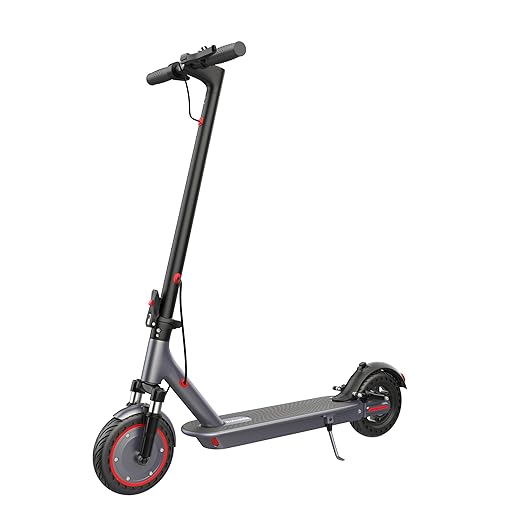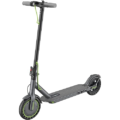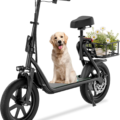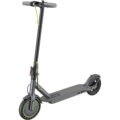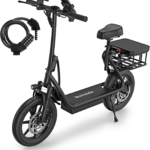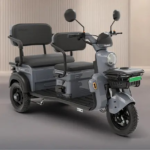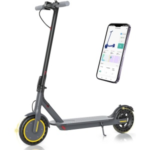- Home
- Scooters
- Electric Scooters
- Roinside UP12
Roinside UP12
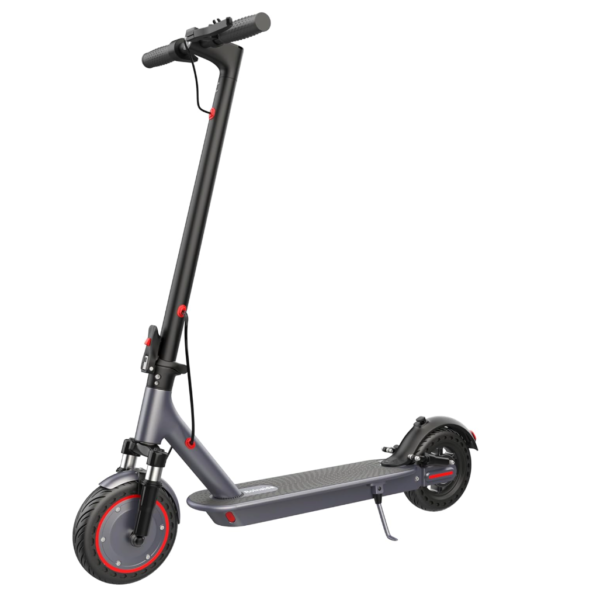


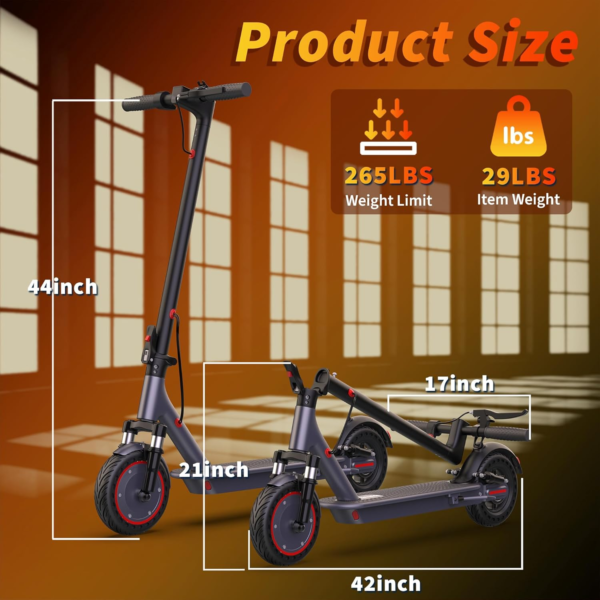
- Battery Range: 15 miles (24 km)
- Top Speed: 19 mph (30 km/h)
- Motor Power: 350 W
- Weight Capacity: 265 lb (120 kg)
- Charging Time: ~4 h
- Scooter Weight: Not specified
PROS
- 8.5″ solid tires (no flats)
- Disc + EABS braking
- Bluetooth app with digital lock
- Foldable commuter frame
- 265 lb (120 kg) load rating
- UL2272 compliance claims by retailers
CONS
- No suspension
- Scooter weight not specified
- IP rating not specified
- Shorter range than premium models
Table of contents
- What Is the Roinside UP12?
- How the Roinside UP12 Works
- Key Specifications (clean table)
- Design & Build Quality
- Performance Fundamentals
- Battery, Range & Efficiency
- Ride Quality & Comfort
- Braking & Safety Features
- Portability & Daily Usability
- Maintenance & Care
- Weather & Seasonal Considerations
- Roinside UP12 vs Alternatives
- Who the Roinside UP12 Is (and Isn’t) For
- FAQs
- Glossary
- Final Thoughts
The Roinside UP12 is a compact, foldable electric scooter built for everyday city travel. It targets riders who want simple controls, low maintenance, and a sturdy build that handles short to mid-length commutes. Moreover, if you prefer solid tires to avoid flats and value an easy carry up stairs, the UP12 fits that brief. Finally, it balances practicality with predictable performance, so beginners feel comfortable quickly. If you’re cross-shopping Roinside models, the Roinside UP8 review is a helpful reference for how the lighter sibling compares in day-to-day use.
What Is the Roinside UP12?
The Roinside UP12 is a lightweight commuter scooter with a 36-volt drive system, a nominal 350-watt hub motor, and 8.5-inch solid rubber tires. Consequently, it prioritizes portability and simplicity over raw power. You unfold the stem, snap a secure latch, power it on, and ride. A rear disc brake pairs with electronic regenerative braking for predictable stopping. Meanwhile, a simple cockpit shows speed, battery, and riding mode at a glance. Stated top speed is around 19 mph (about 30.5 km/h), and stated range lands in the low-to-mid 20-mile bracket under ideal conditions for many riders.
While the UP12 family appears in a few trims, the core idea stays the same: a fuss-free, foldable scooter with a commuter focus. The base UP12 commonly lists 8.5-inch solid tires and a 350 W motor; some “Plus” variants note a 500 W motor and 10-inch solid tires. For clarity, this overview focuses on the base UP12 configuration that most urban riders will encounter. Nevertheless, where relevant, notes highlight potential batch or trim differences.
How the Roinside UP12 Works
At a high level, an electric scooter converts battery energy into wheel motion through a controller and hub motor. Accordingly, here’s how each piece plays out on the UP12:
- Motor: The rear hub (on most commuter batches) houses a brushless DC motor rated at 350 watts nominal. Think of it like a sealed, maintenance-friendly wheel that turns electric energy into forward motion. Because brushless motors are efficient and quiet, they offer smooth pull from a standstill and hold speed on flat ground without drama.
- Controller: The controller acts like the scooter’s “brain.” It sits between the battery and motor and meters power based on your throttle input. When you press the thumb throttle, the controller sends current to the motor in a controlled pattern. Therefore, this determines acceleration feel and energy efficiency. The UP12’s controller also coordinates electronic braking (regen) and typically handles speed-mode limits.
- Battery: A 36-volt pack with capacity in the 7.5–9.0 Ah class is typical for this platform. Thus, the energy content is roughly 280–325 Wh, depending on the exact pack shipped with your unit. Higher capacity means more potential range. Because the pack sits in the deck, the center of gravity remains low, which improves stability.
- Throttle: A right-hand thumb lever is common on the UP12. Press down to accelerate; release to coast. In higher modes the response is brisk but still approachable for new riders. Notably, the throttle throw is short enough to make small speed trims easy.
- Brakes: The UP12 uses a rear mechanical disc plus EABS (electronic anti-lock–style regenerative braking). When you squeeze the lever, the disc adds firm mechanical bite while the controller adds gentle regen to smooth deceleration and recover a bit of energy. Together they shorten stopping distance and make the lever feel more progressive. As a result, riders gain confidence quickly.
This closed system is simple. Charge the battery, power on, select a ride mode (Eco/Drive/Sport is typical), and roll. Because the tires are solid, you skip flat repairs. Furthermore, because the motor is brushless and sealed in the hub, there’s little to maintain beyond brake pads and basic fasteners.
Key Specifications (clean table)
The entries below reflect manufacturer-stated values commonly listed for the base Roinside UP12 configuration. Real-world results vary by rider weight, terrain, temperature, and maintenance.
| Block | Item | Value |
|---|---|---|
| General | Model | Roinside UP12 (base configuration) |
| Intended Use | Urban commuting / last-mile | |
| Rider Weight Limit | Up to 265 lb (120 kg) | |
| Drive System Voltage | 36 V class | |
| Performance & Power | Motor | 350 W nominal brushless hub |
| Stated Top Speed | Up to ~19 mph (≈ 30.5 km/h) | |
| Riding Modes | Eco / Drive / Sport (typical) | |
| Battery, Charging & Electrical | Battery Capacity | ≈ 7.5–9.0 Ah (≈ 280–325 Wh), 36 V class |
| Stated Range | ~21–23 miles (≈ 34–37 km) under ideal conditions | |
| Charging Time | About 4–5 hours (from low to full) | |
| Build & Dimensions | Tire Size & Type | 8.5 in solid rubber (front & rear) |
| Frame Material | Aluminum alloy | |
| Scooter Weight | ≈ 30 lb (≈ 13.6 kg) | |
| Unfolded (L×W×H) | ~40 × 6–6.5 × 18–20 in (≈ 101.6 × 15.2–16.5 × 45.7–50.8 cm) | |
| Folded Dimensions | ~40 × 5.5 × 15 in (≈ 101.6 × 14 × 38 cm) | |
| Safety & Control | Braking | Rear mechanical disc + electronic (EABS/regen) |
| Lighting | LED headlight + tail/brake light; reflectors typical | |
| Water Resistance | Not formally standardized on all batches; ride conservatively in wet | |
| Features & Extras | Display & App | Speed/battery display; app connectivity on most units |
| Cruise Control | Available on many units (toggle via app or hold steady throttle) | |
| Bell & Kickstand | Included | |
| Warranty & Compliance | Safety Compliance | Commonly listed with UL-style battery/charger safety claims |
| Warranty | Varies by seller/region; keep proof of purchase |
Note: Because different UP12 batches exist, some units may ship with slightly different packs or tires. If your carton lists “UP12 Plus,” expect 10-inch solids and a 500 W nominal motor. Conversely, base units typically keep the 8.5-inch wheels and 350 W motor.
Design & Build Quality
The UP12 takes a practical approach. The aluminum frame keeps weight reasonable while resisting corrosion. Welds on the stem and deck are tidy on most units, and the folding latch engages with a positive feel. Additionally, the deck is long enough for staggered feet and bears a grippy top surface, so shoes don’t slide when corners get bumpy.
The cockpit remains deliberately simple. A central LED display shows speed, battery bars, and mode. The right thumb throttle sits close to the grip, which helps fine control on crowded sidewalks. On the left, you’ll usually find the brake lever and a small bell. The headlight mounts on the stem above the display, throwing a low-to-mid beam that’s fine for being seen and acceptable for slow-speed path riding at dusk. Nevertheless, as speeds rise in darker conditions, an auxiliary light is wise.
Fit-and-finish is consistent with other city scooters in this weight class. Panels line up cleanly, cables route inside the stem wherever possible, and the rear fender offers decent spray protection for light puddles. The 8.5-inch solid tires are the star for low maintenance; they’re molded with a puncture-resistant compound that shrugs off nails and glass. However, solids trade some shock absorption for durability. Therefore, expect a firmer ride than you’d get from pneumatic tires.
Finally, portability matters: at roughly 30 lb, the UP12 is manageable for stair carries, train hops, and quick lifts into a car trunk. The folded height stays compact thanks to the short stem and low deck. Importantly, the latch holds tight during carry, which prevents the stem from swinging into your shin.
Performance Fundamentals
Acceleration feel: With a 350 W nominal hub, launch is smooth rather than explosive. In Eco mode, starts are gentle—useful for beginners or crowded paths. Drive mode adds a stronger mid-range pull, while Sport mode delivers the scooter’s best takeoff and top speed. You’ll notice the controller moderates power off the line to keep traction on solid tires. That’s helpful on painted crosswalks and damp pavement; conversely, it feels slightly restrained compared with more powerful scooters.
Cruising stability: At 12–15 mph, the chassis feels calm. The solid tires track straight, and the steering geometry resists twitchiness. Above that, stability remains decent as long as the road stays smooth. Because there’s no suspension, larger potholes or raised joints can kick the deck; bend your knees and keep your weight light over bumps. Moreover, a staggered stance steadies the bar and reduces fatigue.
Hill-climb behavior (~7–10% grades): On short neighborhood rises around 7%, the UP12 holds single-digit speeds without drama for average-weight riders. On longer 8–10% pulls, expect speed to taper. Keep momentum into the hill, and ride in Sport mode. If you regularly face steep grades, the “Plus” variant’s bigger motor and tires may suit you better. Otherwise, plan routes that step around the steepest blocks.
Battery, Range & Efficiency
The UP12’s 36-volt pack in the 280–325 Wh range is aligned with everyday commuting. Stated range near the low-to-mid 20s (miles) assumes a light rider, warm weather, level routes, and conservative speeds. Even so, real-world range depends on many factors:
- Rider weight: Heavier riders draw more current, reducing distance.
- Speed & mode: Higher speed burns energy faster due to air drag; Eco stretches range.
- Terrain: Hills raise consumption; flat loops are kinder.
- Temperature: Cold weather temporarily lowers available capacity.
- Tire type/condition: Solid tires remove inflation variables; that improves consistency. However, debris buildup still hurts efficiency.
Practical expectations: At a mixed urban pace with rolling terrain, many riders should plan for 10–16 miles (16–26 km) before the last bar. Use Drive mode for a good balance of pace and efficiency. If you need more daily mileage, charge at work or plan mid-week top-ups. Additionally, ride at a steady throttle rather than frequent surges; smoother inputs conserve energy.
Charging best practices:
- Let the scooter rest a few minutes after rides before charging; heat equalizes across cells.
- Use the included charger on a stable, ventilated surface; avoid carpets.
- Avoid full discharges; shallow cycles are gentler on lithium cells.
- Unplug when full; store around 50–70% state of charge if you won’t ride for weeks.
- Keep the pack out of hot cars and direct sun; thermal stress shortens life.
With these habits, the pack should deliver consistent range for many cycles. Furthermore, consistent storage temperatures help the BMS maintain balanced cell groups.
Ride Quality & Comfort
Tires: The 8.5-inch solids prevent flats and keep steering precise. They do pass more road texture than pneumatics, so think of the ride as “firm but predictable.” On smoother asphalt the scooter glides nicely. Over brick, chip seal, or expansion joints, soften your knees and ease the throttle to keep the deck settled. Alternatively, choose routes that favor smooth bike lanes and newly paved streets when possible.
Ergonomics: The bar height suits riders across a broad range; elbows stay slightly bent at speed, which helps stability. The deck length supports a staggered stance, easing ankle fatigue. Grips are basic but comfortable, and the thumb throttle angle feels natural on longer runs. Additionally, the brake lever position is easy to adjust, so you can fine-tune reach for smaller hands.
Stem flex: The folding joint and stem exhibit minor flex on hard bumps—normal for a portable commuter. Nothing approaches wobble if your fasteners are snug. Consequently, check the hinge bolts periodically and tighten per the user guide. If you feel play at the latch, stop and address it before continuing.
Noise and vibration: Brushless hubs are quiet. Most noise comes from tire hum and the occasional rattle from accessories on rough pavement. A drop of thread locker on accessory screws (bell, fender bracket) helps. Likewise, a thin rubber shim under a rattly display mount can tame buzz.
Braking & Safety Features
The rear disc brake provides the main stopping force. It bites firmly after about half-lever pull and builds deceleration smoothly. Electronic braking adds gentle drag as you roll off the throttle or squeeze the lever, which stabilizes weight transfer and helps on slick crossings. Because the rear does most of the work, avoid grabbing a full handful on loose gravel; squeeze progressively. Moreover, practice a few controlled stops in an empty lot to learn the bite point.
Lighting includes a forward LED headlight and a tail/brake light. They’re bright enough to be seen at dusk. For truly dark paths, add an external handlebar light for a wider beam. Side reflectors on the deck or stem increase cross-traffic visibility. Additionally, reflective ankle bands boost motion visibility at night.
Water resistance: Some cartons mention splash resistance; others don’t specify an IP rating. Consequently, treat wet rides as exceptions. Slow down in rain, avoid standing water, and dry the scooter after exposure. Electronics dislike deep puddles and pressurized sprays. Afterward, lightly wipe the rotor to remove film that can reduce initial bite.
Helmets and local rules: Always wear a helmet. Gloves and lights help. Local speed and path rules vary by region; set speed limits in the app if available so you remain compliant. When in doubt, ride defensively and yield to pedestrians.
Portability & Daily Usability
Folding: The latch is quick: release the safety, rotate the lever, and fold. A hook usually catches the rear fender for a secure, one-hand carry. The folded length—about 40 inches—fits behind most apartment doors or under a desk. Consequently, multi-modal riders can board trains or buses without blocking aisles.
Carrying & storage: At around 30 lb, the UP12 is manageable for a few flights of stairs. For longer carries, take a brief rest at landings. Indoors, keep it on a doormat to catch tire dust. In offices, fold and park with the kickstand deployed. Furthermore, store the charger in a small pouch clipped to the stem so you never forget it.
Security habits: A compact U-lock or heavy chain through the deck or rear triangle helps deter theft. Pair that with a discreet alarm or a motion-sensing cable if parking outside. Avoid leaving the scooter overnight outdoors, even on a balcony; moisture and temperature swings are hard on electronics. Ultimately, layered security plus indoor storage saves headaches.
Daily routine checklist:
- Battery above two bars before you leave.
- Brake lever pressure firm; rotor not rubbing.
- Folding latch fully engaged (no play).
- Tires clean; no embedded metal or glass.
- Lights working; display readable.
Because this checklist takes under a minute, it quickly becomes habit and prevents most avoidable issues.
Maintenance & Care
Although the UP12 is low-maintenance, a simple routine keeps it feeling new:
Before each week:
- Fastener check: Snug the stem hinge bolts, rotor bolts, fender screws, and clamp. Don’t overtighten; use hand tools, not impact drivers. Additionally, re-check after any big pothole hit.
- Brake test: Roll the scooter and squeeze the lever. If the lever pulls too easily or feels spongy, adjust cable tension at the caliper barrel and inspect pads for wear. Then bed the pads with several moderate stops.
- Tire inspection: Solids don’t puncture, but debris can cut grooves. Remove sharp objects and wipe the surfaces. Consequently, the ride stays smooth and efficient.
Monthly:
- Rotor alignment: If you hear a soft “ting-ting,” the rotor might be slightly bent. Minor wobbles can be trued with a rotor tool or by a bike shop. Meanwhile, ensure the caliper is centered over the rotor.
- Hinge lubrication: A drop of light lubricant on the latch pivot keeps folding smooth. Wipe off excess so dust doesn’t stick.
- Firmware/App habits: If your unit pairs with an app, check for updates and re-calibrate speed limit or cruise control preferences. Additionally, confirm that your odometer and battery readouts look consistent.
Seasonal (or every 500–700 miles):
- Brake pads: Replace when friction material thins to 1–1.5 mm. Bed new pads properly; otherwise, bite will feel glazed.
- Battery health check: If range drops suddenly, record ride logs for several days. Balanced charging (full charge, rest, then short ride) can help even cell groups. If the drop persists, consider professional assessment.
- Full bolt audit: Use a torque reference where available; otherwise, “snug plus a quarter-turn” is a safe hand-tight rule on M5/M6 hardware. Importantly, never torque the stem clamp unevenly.
Store the scooter between 50–77°F (10–25°C) and around 50–70% charge if it will sit for weeks. Avoid leaving it inside hot cars or in freezing sheds. Likewise, keep the charger in a dry, ventilated space.
Weather & Seasonal Considerations
Rain: Traction falls on painted lines and metal grates. Start gently, brake earlier, and keep speeds low. After wet rides, dry the deck, stem, and brake rotor. Never spray the scooter with a pressure washer; use a damp cloth instead. Additionally, lubricate the latch pivot after repeated wet days.
Heat: High temperatures age battery cells. Park in the shade, and let the scooter cool before charging. Heat also softens rubber and can make solids feel slightly more compliant—nice for comfort, but remember that bearing grease thins too. Therefore, avoid prolonged full-throttle runs in extreme heat.
Cold: Below ~45°F (7°C), expect lower range. Plan shorter rides, pre-warm the scooter indoors, and charge at room temperature. Grips stiffen slightly in the cold; gloves help. Furthermore, use Drive rather than Sport to reduce peak current draw.
Dust & grit: After dry, dusty rides, wipe the hub and caliper. Grit on rotors accelerates pad wear. A quick towel rub makes a big difference. Consequently, you’ll hear less brake squeal and feel more consistent bite.
Roinside UP12 vs Alternatives
The UP12 sits in the light commuter class. Here’s how it compares in use-case terms:
- Versus basic last-mile scooters (entry models): The UP12 usually feels sturdier and a touch faster. Solid tires and a rear disc are upgrades over single-brake, tube-tire competitors that often suffer pinch flats. Additionally, the display and modes offer more control.
- Versus mid-commuter scooters (bigger batteries, 10-inch pneumatics): Those ride softer and push higher real-world range. However, they weigh more and demand tire maintenance. If you prioritize comfort over weight, a pneumatic 10-inch model can be compelling. Conversely, if you value simplicity, the UP12 wins.
- Versus performance scooters (dual motors or ≥ 800 W nominal): Performance models crush hills and sprint, yet they’re heavy, expensive, and can be overkill for bike lanes. The UP12 is simpler and easier to live with. Consequently, it suits riders who value predictability more than peak thrust.
- Off-road or suspension-focused scooters: If you need shocks for trail use, look elsewhere. The UP12’s value is paved-path efficiency, not dirt play. Nevertheless, it handles occasional park paths if you slow down for roots and seams.
When the UP12 excels: dense cities, short stair carries, multimodal trips (bus/train), and riders who never want to fix a flat.
Where it shows limits: steep, extended climbs; rough, broken pavement; long suburban commutes without charging access.
Prefer something even lighter for short, flat trips? Explore specs and fit on the Roinside UP8 to see if that platform better matches your priorities.
Who the Roinside UP12 Is (and Isn’t) For
Ideal for:
- Students and urban commuters who need an easy fold, low weight, and consistent daily performance.
- Apartment dwellers who carry up a flight or two and store under a desk.
- Riders who hate flats and prefer solid tires for no-fuss upkeep.
- Beginners who want balanced acceleration, clear modes, and predictable brakes.
Not the best fit for:
- Hill-heavy routes beyond short 7–10% grades.
- Riders seeking plush comfort on cracked or cobbled streets; consider larger pneumatic tires.
- Speed enthusiasts who want 25+ mph performance; the UP12 is tuned for city limits.
Because rider needs differ, consider your terrain, commute length, and storage situation first. Then weigh comfort versus maintenance. The UP12 leans strongly toward low-stress ownership.
FAQs
1) Is the Roinside UP12 fast enough for city commuting?
Yes. With a stated top speed near 19 mph (30.5 km/h), it keeps pace on most bike lanes. Use Sport mode for headwinds, and shift to Drive in crowded areas. Moreover, set cruise on calmer stretches to reduce fatigue.
2) How far can I go on a single charge?
Stated range sits in the low-to-mid 20 miles under ideal conditions. Real-world mixed riding often lands in the 10–16 mile window depending on rider weight, terrain, and speed habits. Therefore, plan with a small buffer if you’re new to electric commuting.
3) Does it have cruise control?
Many UP12 units include cruise control that engages after holding a steady throttle for several seconds. It can usually be toggled in the app or via a button sequence. Consequently, longer straight sections feel easier on the thumb.
4) What maintenance does the UP12 need?
Keep bolts snug, adjust the rear brake cable as pads wear, wipe dust from the rotor, and keep the battery charged. Solid tires eliminate flats, which simplifies life. Additionally, a monthly hinge lube keeps folding smooth.
5) Can I ride in the rain?
Light splashes are typically fine if you slow down and avoid standing water. Because water resistance varies by batch, treat rain rides as occasional and dry the scooter afterward. Importantly, never pressure-wash the deck or hub.
6) What makes this Roinside UP12 overview useful?
You get a clear look at the UP12’s commuter-first design, its motor and battery behavior, braking feel, maintenance habits, and realistic use cases without hype. Consequently, you can decide quickly whether it matches your route and routine.
7) Is the UP12 good for hills?
On short neighborhood grades around 7%, yes. On extended 8–10% climbs, expect speeds to fall. For steeper terrain, consider a higher-power alternative. Otherwise, plan routes that avoid the steepest segments.
Glossary
- Ah (Amp-hours): Battery capacity measure. Higher Ah suggests more stored energy at a given voltage.
- Wh (Watt-hours): Battery energy (Wh = V × Ah). Consequently, it’s a better indicator of potential range than voltage alone.
- Controller: Electronics that meter battery power to the motor based on throttle input and mode.
- Regen (Regenerative Braking): Uses the motor to slow the scooter and send a bit of energy back to the battery.
- EABS: Electronic anti-lock-style braking logic that reduces wheel lock during braking.
- Brushless Hub Motor: A sealed motor inside the wheel for low maintenance and efficient propulsion.
- Stem Flex: Small, normal deflection at the folding joint or stem under load; excessive play means adjustment is needed.
- IP Rating: Ingress Protection code for dust/water resistance. Not all batches list one; therefore, ride conservatively in wet conditions.
- Pneumatic Tire: Air-filled tire that cushions bumps but can puncture.
- Solid Tire: Puncture-proof tire made of dense rubber; transmits more road texture than pneumatics.
- Mode (Eco/Drive/Sport): Preset power limits that change acceleration and max speed.
- Nominal vs Peak Power: Nominal is continuous rating; peak is short bursts for acceleration or hill starts.
- UL-Style Safety Claims: Battery/charger compliance statements common to consumer e-mobility; check your carton/manual.
- Deck: Standing platform that houses the battery.
- Kickstand: Side stand that props the scooter when parked.
- BMS (Battery Management System): Electronics that manage charging, discharging, and cell balancing.
Final Thoughts
The Roinside UP12 sticks to a proven commuter formula: a 36 V hub motor, a compact folding frame, and solid tires that keep you rolling day after day. It trades plushness for freedom from flats and emphasizes predictability over flash. If your commute is mostly flat, your storage space is tight, and you want a scooter that simply works, the UP12 belongs on your shortlist. Use Eco for crowded paths, tap Sport for headwinds, and keep an eye on the battery bars. With basic care, it’s a dependable daily tool that saves time and makes short trips enjoyable. Furthermore, because maintenance is minimal, you can focus on riding instead of wrenching.
Specifications
General
| Model The Model specifies the exact version or name of the scooter. It helps identify its unique design, features, and specifications within the manufacturer’s product line. Knowing the model makes it easier to compare options, find compatible accessories, or look up support information. | UP12 |
| Brand The Brand identifies the manufacturer or company that designs and produces the scooter. A trusted brand is a sign of quality, reliability, and good customer support. Well-known brands often have higher standards for safety, performance, and after-sales service, giving you more confidence in your purchase. | Roinside |
| Release Date The Release Date indicates when the scooter model was officially launched on the market. This helps you know how current the design, technology, and features are. A newer release date often means updated components, improved performance, and the latest safety or smart features. | 17 November 2025 |
| Recommended Age Recommended Age indicates the minimum age range that the scooter is designed for, based on safety, size, and ease of use. Following the recommended age helps ensure that riders can handle the scooter’s speed, weight, and controls comfortably and safely. Always check local laws and use protective gear, especially for younger riders. | +16 |
Performance & Power
| Motor Power (Wattage) What it means: The motor power, measured in watts (W), shows how strong the scooter’s electric motor is. Why it matters: Higher wattage usually means better acceleration, more torque, and improved performance on hills or rough terrain. For example, a 250W motor is good for flat city roads and light riders, while a 500W or 1000W motor provides more power for faster speeds or climbing steep inclines. | 350 W brushless hub motor |
| Top Speed The Top Speed indicates the maximum speed that the scooter can reach under optimal conditions. It’s usually measured on level ground with a fully charged battery and an average rider weight. A higher top speed allows you to travel longer distances faster, but always ensure you ride within legal speed limits and your personal comfort zone for safety. | 19 mph (30 km/h) |
| Battery Capacity Battery Capacity refers to the total amount of energy the scooter’s battery can store, usually measured in ampere-hours (Ah) or watt-hours (Wh). A higher battery capacity means you can ride longer distances on a single charge, reducing the need for frequent recharging. Keep in mind that actual range can vary depending on rider weight, terrain, speed, and weather conditions. | 36 V 7.8 Ah (323 Wh) |
| Estimated Range per Charge The Estimated Range per Charge indicates the average distance the scooter can travel on a single full battery charge. This range is calculated under optimal conditions, such as flat terrain, moderate speed, and average rider weight. Real-world range may vary depending on riding style, terrain, weather, and load. A longer range means fewer recharges and greater freedom for longer trips. | 15 miles (24 km) |
| Hill Climb Ability Hill Climb Ability describes the maximum incline or slope that the scooter can handle while maintaining stable performance. It’s typically expressed as a percentage or in degrees. A higher hill climb rating means the scooter can tackle steeper hills without losing too much speed or power. Actual climbing performance may vary based on rider weight, battery charge, and terrain conditions. | Not specified |
| Drive System The Drive System refers to how power from the motor is delivered to the wheels. Electric scooters typically use either a hub motor (directly integrated into the wheel) or a chain/belt drive system. A high-quality drive system ensures smooth acceleration, efficient power transfer, and low maintenance. The choice of drive system affects performance, noise level, and overall ride experience. | Not specified |
Charging & Electrical
| Charging Time Charging Time indicates how long it takes to fully recharge the scooter’s battery from empty to 100% using the standard charger provided. Faster charging means less downtime and more time on the road. Actual charging time may vary slightly depending on battery capacity, charger output, and environmental conditions. | Approx. 4 hours |
| Battery Type Battery Type refers to the specific technology used in the scooter’s battery, which affects performance, lifespan, weight, and charging time. Most modern electric scooters use high-quality lithium-ion (Li-ion) batteries because they offer a good balance of energy density, durability, and low maintenance. A reliable battery type ensures consistent power delivery and longer riding ranges. | Lithium-ion (BMS not specified) |
| Removable Battery A Removable Battery means the battery pack can be easily detached from the scooter for convenient charging and replacement. This feature allows you to charge the battery separately, swap it with a spare for extended range, or securely store it indoors in extreme weather. Removable batteries add flexibility and make it easier to keep your scooter powered up wherever you are. | Non-removable internal battery (fixed pack) |
| Regenerative Braking Regenerative Braking is an energy-saving feature that converts some of the energy normally lost during braking back into battery power. When you slow down or brake, the motor works in reverse to generate electricity, which helps extend the scooter’s range and improves overall efficiency. This system also reduces wear on traditional brake components, leading to lower maintenance over time. | Yes (via EABS electronic brake) |
| Lighting Lighting refers to the built-in front and rear lights that enhance visibility and safety when riding in low-light conditions or at night. Good lighting helps you see the road ahead and ensures that other road users can see you. Many scooters include LED headlights, taillights, and sometimes brake lights or side reflectors for added safety and compliance with local traffic regulations. | Not specified |
Build & Dimensions
| Scooter Weight Scooter Weight refers to the total weight of the scooter when fully assembled, including the battery. This affects how easy it is to carry, lift, and store the scooter when not in use. A lighter scooter is more portable and convenient for commuting, especially if you need to carry it upstairs or onto public transport. Keep in mind that a sturdy frame and quality components may add to the weight but also contribute to better durability and ride stability. | Not specified |
| Maximum Rider Weight Maximum Rider Weight indicates the highest rider weight that the scooter is designed to safely support while maintaining optimal performance and stability. Staying within this limit helps ensure reliable acceleration, braking, and climbing ability, and it protects the frame, suspension, and motor from excessive strain. Exceeding the recommended limit may reduce performance and increase wear on components. | 265 lb (120 kg) |
| Deck Size Deck Size refers to the dimensions of the scooter’s standing platform. A wider and longer deck provides more foot space, allowing you to stand comfortably and adjust your stance while riding. A well-sized deck improves balance and stability, especially on longer rides or at higher speeds. Compact decks, on the other hand, help keep the scooter lightweight and portable. | Folding commuter frame |
| Handlebar Height Handlebar Height refers to the distance from the deck to the handlebars, which affects your riding posture and comfort. An appropriate handlebar height helps you maintain good balance, reduces strain on your back and arms, and makes steering more comfortable. Some scooters have adjustable handlebars to fit riders of different heights, while others have a fixed height for a streamlined design. | Fixed (height not specified) |
| Folding Mechanism The Folding Mechanism describes how easily and securely the scooter can be folded for carrying and storage. A well-designed folding system lets you quickly collapse the scooter into a compact size, making it convenient to transport on public transit, store under a desk, or fit into a car trunk. Look for sturdy latches and safety locks to ensure the scooter stays firmly in place when folded or unfolded. | One-click folding latch |
| Dimensions Folded Dimensions indicate the size of the scooter when it’s fully folded. This measurement shows how much space the scooter will take up when stored or carried, making it easier to check if it will fit in your car trunk, under a desk, or in a closet. Compact folded dimensions are ideal for commuters who need to bring their scooter on public transport or store it in tight spaces. | Folded: Not specified; Unfolded: Not specified |
| Material Material refers to the primary construction materials used for the scooter’s frame and key components. High-quality materials like aircraft-grade aluminum, reinforced steel, or durable composites provide strength, stability, and a lighter overall weight. A sturdy material ensures the scooter can handle daily wear and tear while maintaining safety and performance. | Aluminum alloy |
Safety & Control
| Brake Type(s) Brake Type(s) describe the braking systems the scooter uses to help you slow down or stop safely. Common brake types include mechanical brakes (like drum or disc brakes), electronic brakes, and foot brakes. Many scooters combine multiple braking systems for added safety and shorter stopping distances. The type and quality of brakes affect your control, especially when riding at higher speeds or on slopes. | Disc brake + EABS electronic brake |
| Suspension Suspension refers to the system that absorbs shocks and vibrations while riding, providing a smoother and more comfortable ride over uneven or rough surfaces. Scooters may have front suspension, rear suspension, or dual suspension for better shock absorption and stability. Good suspension helps reduce rider fatigue and improves control, especially when riding on bumpy roads or off-road paths. | None |
| Tire Type Tire Type refers to the kind of tires the scooter uses, which directly affects ride comfort, traction, and maintenance. Common types include solid (airless) tires, pneumatic (air-filled) tires, or hybrid options. Pneumatic tires offer better shock absorption and a smoother ride on rough surfaces, while solid tires are puncture-proof and require less upkeep. The right tire type helps ensure safe handling and a comfortable ride in different conditions. | 8.5″ solid rubber tires |
| Tire Size Tire Size indicates the diameter and width of the scooter’s tires, which affect ride comfort, stability, and how well the scooter handles different terrains. Larger tires generally offer better shock absorption and a smoother ride over bumps and rough surfaces, while smaller tires keep the scooter lighter and more portable. Choosing the right tire size helps ensure a balance between agility and comfort. | 8.5-inch |
| Kickstand The Kickstand is a built-in stand that allows you to park your scooter upright when it’s not in use. A sturdy kickstand keeps the scooter stable and prevents it from tipping over, protecting it from scratches and damage. It also makes storing and accessing your scooter more convenient, whether you’re at home, work, or on the go. | Not specified |
| Water Resistance Rating Water Resistance Rating indicates how well the scooter is protected against water and moisture, usually shown as an IP (Ingress Protection) rating. This rating helps you understand whether the scooter can handle light rain, splashes, or wet roads without damage. While most scooters are not fully waterproof, a good water resistance rating adds peace of mind when riding in changing weather conditions. Always avoid deep puddles or submerging the scooter to protect its electrical components. | Not specified |
Features & Extras
| Display/Console The Display (or Console) shows important real-time information about your ride, helping you monitor your scooter’s status at a glance. Typical displays show speed, battery level, distance traveled, and riding mode. Some models also include additional features like Bluetooth connectivity, app integration, or backlighting for better visibility at night. A clear and easy-to-read display enhances safety and convenience on every trip. | LED display (speed, battery) |
| Ride Modes Ride Modes refer to the different speed and power settings you can choose to match your riding style or road conditions. Common modes include eco for maximum range and energy efficiency, standard for everyday balance, and sport or turbo for higher speed and stronger acceleration. Switching between ride modes allows you to customize performance, conserve battery, and ride safely in various environments. | Multiple riding modes (not specified) |
| Smart App Connectivity Smart App Connectivity lets you pair your scooter with a dedicated mobile app via Bluetooth. Using the app, you can monitor real-time ride stats like speed, battery level, and range, adjust settings such as ride modes or cruise control, lock the scooter for added security, and sometimes receive firmware updates. This feature adds convenience and allows you to personalize your riding experience right from your smartphone. | Bluetooth companion app: speed mode, lock |
| Anti-Theft System The Anti-Theft System helps protect your scooter from unauthorized use or theft. This feature can include built-in alarms, electronic motor locks, GPS tracking, or remote locking through a mobile app. A good anti-theft system provides peace of mind when parking your scooter in public spaces, adding an extra layer of security to safeguard your investment. | App lock |
| Cruise Control Cruise Control allows you to maintain a steady speed without continuously holding the throttle. This feature makes longer rides more comfortable by reducing hand fatigue and providing a smoother, more relaxed riding experience — especially on flat, open roads or bike lanes. For safety, cruise control can usually be easily activated or deactivated while riding. | Yes (cruise control) |
| Accessories Included Accessories Included lists the additional items that come with the scooter to enhance your riding experience and convenience. Common accessories may include a charger, kickstand, bell, lights, phone holder, or carrying strap. These extras add value by making your scooter safer, easier to use, and ready to ride straight out of the box. | Scooter, charger, tools, manual |
Warranty & Compliance
| Warranty Period The Warranty Period indicates how long the manufacturer guarantees the scooter against defects in materials and workmanship under normal use. A good warranty provides peace of mind, showing the brand’s confidence in its product quality. Always check what parts are covered, such as the frame, battery, and motor, and follow the maintenance guidelines to keep your warranty valid. | Region-dependent |
| Certifications Certifications confirm that the scooter meets specific safety, quality, and environmental standards set by recognized organizations or regulatory bodies. Common certifications may include CE, RoHS, UL, or other local compliance marks, depending on your region. These certifications ensure that the scooter is manufactured to high standards and is safe and legal to use in your country. | UL2272 (per retailer listings) |



